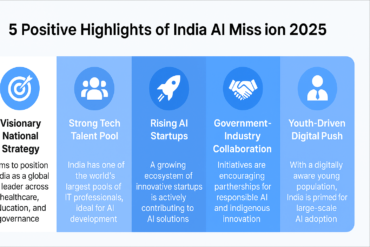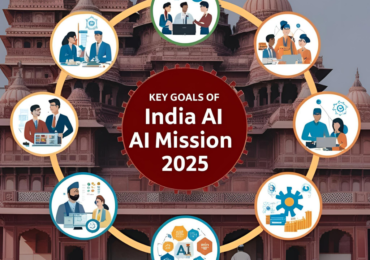India stands at the cusp of an AI-driven transformation. With the launch of India AI Mission 2025 , the country seeks to become a global leader in artificial intelligence. The mission aims to reshape governance, empower industries, and upskill millions of Indians for the future. But can India really compete with giants like the U.S. and China in this high-stakes race? This article breaks down the mission, achievements, challenges, and future pathways to answer a vital question: Can India lead the global AI race through India’s AI Mission 2025?
What Is India AI Mission 2025?
India AI Mission 2025 is a national strategy to embed AI in all major sectors—healthcare, education, agriculture, and governance. It was launched under the Ministry of Electronics and IT (MeitY) with collaboration from NITI Aayog and other national institutions.
Core objectives of India AI Mission 2025 include:
- Setting up 20+ AI Centres of Excellence in top academic institutions
- Training 1 million youth in AI, ML, and data science
- Boosting AI startups with funding and innovation labs
- Promoting AI for public good—especially in rural and underserved regions
- Establishing ethical and regulatory frameworks for responsible AI
The mission also aims to ensure inclusive digital growth by integrating AI into the Digital India initiative.
Why Is India AI Mission 2025 Critical for National Growth?
India’s AI Mission 2025 is not just a tech policy—it is an economic and strategic imperative. Here’s why:
- $500 Billion GDP Contribution: As per Nasscom and McKinsey, AI can add up to $500 billion to India’s GDP by 2025.
- Massive Employment Potential: AI is expected to generate over 20 million new jobs in India by 2025.
- Enhancing Public Services: AI can revolutionize healthcare diagnostics, precision agriculture, and e-learning platforms.
- Digital India Goals: It reinforces the vision of Digital India by making AI tools accessible to all.
- Strategic Tech Sovereignty: Reduces reliance on foreign AI technologies by developing indigenous capabilities.
Clearly, India AI Mission 2025 is essential not only for growth but also for self-reliance in emerging technologies.
Links Suggested: Digital India and Cyber Security: Balancing Innovation and Protection
India AI Mission 2025: Key Milestones So Far
India’s journey in AI began with early policy frameworks and has steadily matured over time. Some major achievements of India’s AI Mission 2025 include:
- National AI Strategy (2018): A landmark policy by NITI Aayog that categorized AI use cases and laid the foundation for the mission.
- AI Research Hubs: Centres in cities like Bengaluru, Chennai, and Hyderabad now lead research in NLP, computer vision, and GenAI.
- Public AI Platforms: The launch of the India Datasets Platform to provide anonymized public datasets for training models.
- AI in Governance: Use of AI in land record digitization, FASTag toll systems, e-Courts, and PM GatiShakti is now mainstream.
- AI in Health: Startups like Niramai and Qure.ai use AI for early-stage breast cancer and tuberculosis detection.
India’s AI Mission 2025 is already showing promising results—but this is just the beginning.

How India AI Mission 2025 Is Positioning the Country Globally
Globally, India is shaping itself as a responsible, inclusive, and scalable AI powerhouse.
- Leadership in GPAI: India co-chairs key areas in the Global Partnership on AI (GPAI) alongside the EU and OECD nations.
- Global AI Ethics Dialogue: Through G20 summits and tech forums, India is promoting frameworks for ethical AI development.
- Digital Public Infrastructure (DPI): The India Stack (Aadhaar, UPI, DigiLocker) is now seen globally as a model for scalable AI integration.
- Talent Export: Indian AI engineers lead global tech teams at Google, Microsoft, and OpenAI.
With India AI Mission 2025, the country is transitioning from a back-end service provider to a frontline innovator.
Links Suggested: India-Bangladesh Relations: Why India Withdrew the Trans-Shipment Facility
Challenges Slowing Down India’s AI Mission 2025
Despite its strategic vision, India AI Mission 2025 is hindered by several critical challenges that must be addressed to achieve meaningful progress and global competitiveness.
1. Infrastructure Gaps
India lacks robust AI-ready infrastructure such as high-performance computing systems and advanced GPUs. Limited access to scalable cloud-based AI platforms further hinders model training and deployment, slowing innovation and making India dependent on foreign infrastructure, especially in deep learning and generative AI segments.
2. Skilled Workforce Shortage
There’s a growing demand for AI engineers, data scientists, and ML researchers, but India’s academic institutions and training pipelines aren’t producing enough industry-ready professionals. The skill gap delays AI adoption in sectors like healthcare, agriculture, and education, threatening the long-term goals of Mission 2025.
3. Regulatory Uncertainty
The absence of a comprehensive legal framework for AI—including data privacy, ethical usage, and liability—creates uncertainty for businesses and investors. Without clear regulations like the EU’s AI Act, India risks losing both domestic and international momentum in developing trustworthy and responsible AI systems.
Links Suggested: India-China Trade War: Can India Adopt Trump’s Economic Playbook?
4. Limited R&D Spending
India invests only 0.7% of its GDP in research and development, well below global benchmarks. This underinvestment restricts innovation, public-private partnerships, and long-term AI research. In contrast, countries like China and the U.S. have built massive AI ecosystems fueled by higher R&D investments.
5. Urban-Rural Digital Divide
AI adoption is concentrated in metropolitan areas. Rural India suffers from weak internet access, low digital literacy, and lack of AI-related educational outreach. This disparity undermines inclusive development and prevents equitable access to AI-driven services in agriculture, health, and local governance.
India’s AI Mission 2025 has the potential to transform governance, economy, and society—but only if it tackles these foundational challenges. Accelerated infrastructure development, regulatory clarity, upskilling, increased R&D spending, and bridging the rural digital divide are essential to unleash India’s full AI potential.

What’s Next for India AI Mission 2025?
To maintain momentum, the government is taking strategic steps in 2025:
- AI in Regional Languages: Promoting NLP and GenAI tools in Hindi, Tamil, Bengali, and other local languages.
- Startup Sandbox: Establishing AI-focused incubation zones in Tier 2 & 3 cities.
- AI + 5G Synergy: Building platforms where AI and 5G converge for real-time applications like smart cities and autonomous vehicles.
- National AI Supercomputing Grid: A ₹10,000 crore investment plan to build India’s AI supercomputers.
- Responsible AI Framework: A draft bill is expected to regulate deepfakes, data misuse, and AI-driven misinformation.
India’s AI Mission 2025 is evolving into a whole-of-society movement—driven by startups, academia, government, and global allies.
Conclusion: Will India AI Mission 2025 Win the Global Race?
India AI Mission 2025 is ambitious—but also achievable. With a strategic blend of innovation, inclusivity, and infrastructure, India is charting its own path in the AI era. While challenges like digital access and regulatory clarity remain, India has the talent, market, and momentum to lead—not just follow—the global AI movement.

